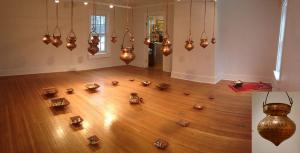Pritika Chowdhry’s anti-memorial commemorates the 20th Anniversary of the Gujarat Pogrom
"Memory Leaks: Spectres of Partition" is an anti-memorial to the Gujarat Pogrom of 2002 in the form of a sculptural art installation by artist Pritika Chowdhry.
For many Indians, including me, the Gujarat Pogrom of 2002 was a tipping point. The scale and extreme brutality of the violence clearly harked back to the Partition violence of 1947.”
CHICAGO, IL, USA, February 25, 2022 /EINPresswire.com/ -- The installation Memory Leaks: The Spectres of Partition is part of Chowdhry’s Partition Memorial Project, an ongoing series comprised of more than nine installations presenting the fallout from India’s Partition. To commemorate the 75th anniversary of India’s Partition, Chowdhry will be blogging about related historical events throughout the year on her artist website.— Pritika Chowdhry
February 27th, marks the 20th anniversary of the Gujarat Pogrom, arguably the most significant communal riot since 1947, and is an apt time to revisit Chicago-based, Indian-born socio-political, feminist artist Pritika Chowdhry installation Memory Leaks: The Spectres of Partition. First on view in 2013, this site-sensitive durational installation is comprised of seventeen dharapatras, Hindu ritual copper vessels, etched with details of as many Hindu-Muslim communal riots.
Through her art and writing, Chowdhry centers a large part of her artistic practice on the Partition of India and the events that followed. The installation Memory Leaks is comprised of ritual copper vessels used in Hindu temples for cleansing through water and fire. Dharapatras, which are copper pots with a spouted bottom, are used in Hindu temples to drip water or milk on deities. Havans are copper containers used in Hindu temples to light the holy fire and make offerings to the fire. They are presented as a durational installation with water dripping out of the bottom of seventeen Dharapatra vessels into seventeen havans. Each of the havans contain partially burnt books written in Urdu, the language spoken by Muslims in India and Pakistan.
In 2002, in the state of Gujarat in India, a brutal and planned pogrom was conducted against the Muslim minority by the Hindu right, which left over 2000 people dead and several thousand injured. Sexual violence against Muslim women was widely used as a method of subjugating and humiliating the Muslim community. It occurred right after the tenth anniversary of the Babri Masjid demolition in December 1992. For many Indians, including Chowdhry, the Gujarat Pogrom was a tipping point.
The narrative of the Partition violence is similarly polarized in India and Pakistan to paint the other community as the aggressor and violent one, and the home community as the noble and righteous victim. Hence, the memory of the Partition is continually ‘leaking’ into the present to recreate the same emotional reactions of fear, violence and blame. Memory Leaks has been exhibited as part of the “Islamic Exchange” series at the Kansas City Artists’ Coalition gallery in 2013, and in a solo exhibition titled “Karmic (dis)Continuities” at the Banfill Locke Center for the Arts, also in 2013, in Minneapolis, MN.
Relying on research and literature, Chowdhry’s work links the Partition of India and Hindu-Muslim communal riots. In The Production of Hindu-Muslim Violence in Contemporary India (2003) Brass coins the phrase, ‘Institutionalized Riot System ‘(IRS) to explain the dramatic production of riots on a regular basis in India, which Brass has divided into three phases: preparation, activation and explanation. “I, as a Hindu, owed it to the Muslim minority in India to reveal this complex and callous socio-political system, through my artwork,” Chowdhry says. The seventeen communal riots that form the conceptual basis of Memory Leaks are all mentioned in Asghar Ali Engineer’s book, Communal Riots after Independence: A Comprehensive Account (2004). In this extensive book, Engineer has presented tabulated data on almost all the communal riots that have occurred in India from 1947 to 2002.
“My hypothesis with this artwork is that the Hindu Right's Institutionalized Riot Systems appropriate narratives of the Partition violence to interpellate and galvanize their Hindu right base into participating in the riots. So, the memory of the Partition violence is continually being harnessed in the present day, to instil fear-based aggression in the minds of Hindus and to demonize the Muslim minority population,” says Chowdhry. Importantly, “I believe this is a key component to understanding the continuing cycles of communal riots in India.”
Memory Leaks is an anti-memorial, adopting a term coined by James E. Young,. “State-sponsored monuments have a very specific purpose – their purpose is to hail us into the position of nationalistic and patriotic subjects. To be that, to be a nationalistic and patriotic subject, we need to forget the misdeeds of our nation-states. We need to believe that our nation is noble, fair, and egalitarian. In order to believe that we need to forget the traumatic events that happened in order for our country to be born as a nation-state,” says Chowdhry. Unlike an official fixed memorial or monument, Memory Leaks is temporary and does not glorify any nation-state. Instead, the installation excavates a subjugated version of events serving as an act of resistance against the official versions of the Gujarat Pogrom which, to both Hindus and Muslims, perpetuates hostility against the other.
The installation Memory Leaks: The Spectres of Partition is part of Chowdhry’s Partition Memorial Project, an ongoing series comprised of more than nine installations presenting the fallout from India’s Partition. Learn more about the Partition and its many facets on Chowdhry’s blog and website. Learn more about the Partition and its many facets on Chowdhry’s blog and website.
Anna Mikaela Ekstrand
CultBytes
+1 720-254-2997
email us here
Legal Disclaimer:
EIN Presswire provides this news content "as is" without warranty of any kind. We do not accept any responsibility or liability for the accuracy, content, images, videos, licenses, completeness, legality, or reliability of the information contained in this article. If you have any complaints or copyright issues related to this article, kindly contact the author above.

